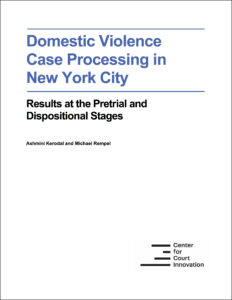-
Ashmini Kerodal
-

Michael Rempel
This publication documents how New York City’s domestic violence cases are handled at each stage of the criminal justice process, from pretrial to sentencing. Relying on data from cases arraigned in 2012, 2013, and 2014, the publication serves as a companion piece to an earlier work that examined the path of all New York City cases—without specifically isolating domestic violence. The current study seeks to answer questions such as: to what extent do prosecutors decline to prosecute domestic violence cases; how often do judges release domestic violence defendants on their own recognizance or set bail, and based on which factors; to what extent are release and sentencing decisions informed by risk; and how do decisions and outcomes vary based on race, ethnicity, and gender?
